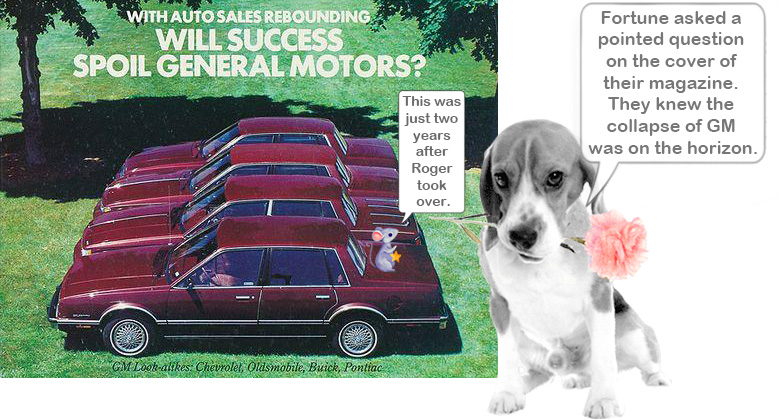It is easier to increase sales than it is to cut expenses.
In the words of Adrian Van Zelfden, “You cannot shrink your way to profit.”
Cost-cutting CEO’s are hailed as geniuses by Wall Street and lauded as saviors by private equity firms because cost-cutting always works in the short-term.
But that’s not how you build a business.
When Roger Smith rose from his position of accounting clerk to become CEO of General Motors in 1981, Wall Street saw him as a brilliant businessman who was “optimizing operations” and “maximizing profits.” But anyone who loved cars could see that he was destroying one of America’s great companies.
When I complained to one of my brothers-in-law that the GM brands were rapidly losing their distinct identities to become a bland blend of nothingness, he said, “You don’t understand business. It costs a lot to engineer and tool a new model of car for each GM brand,” (Chevrolet, Pontiac, Oldsmobile, Buick and Cadillac,) “so Roger Smith is building all the cars on a single platform. But each brand will get its own grill and headlights and interior and taillights.”
I said, “Perhaps I don’t understand business, but I understand marketing and reputation-building from the hair of my head to the soles of my feet and I’m telling you that Roger Smith is destroying General Motors.”
Every time I point out the dangers of an unsustainable plan to cash in on the 90-day attention span of the American investor, I am told, “You don’t understand business.”
Always those same four words.
Prior to the arrival of “optimizing, maximizing” Roger Smith in 1981, GM held 46% of the U.S. car market. By the time he left 9 years later, market share had slipped to 35.4% and was rapidly falling. When asked about the plummeting market share, he defended the bottom line: “You don’t pay dividends on market share.”
By depriving his brands of the oxygen of creativity and innovation, Roger Smith choked the life out of General Motors.
Oldsmobile died. Pontiac died. Buick is not far behind. GM’s market share in 2021 was only 15.2% of the U.S. car market.
This did not have to happen.
“Critics say Smith’s greatest flaw was overemphasizing that bottom-line mentality rather than working on improving product quality. ‘He was a bean counter,’ says Owen Bieber, who was president of the United Auto Workers during much of Smith’s tenure. ‘Suddenly, GM started making a lot of cars that looked alike. I used to tell him that you can’t have a Cadillac that looks like a Chevrolet and expect to sell them both.’”
– Los Angeles Times, Dec 1, 2007
By 1989 GM was losing $2000 on every GM10 it built. Asked by Fortune magazine why the program had failed, Roger Smith answered: “I don’t know. It’s a mysterious thing.”
In June, 2009, when GM dropped to its knees and begged the bankruptcy courts for mercy, Motor Trend magazine had this to say,
“Less than a year after celebrating its centenary, the company we knew as General Motors is dead. Once the richest and most powerful automaker in the world; the symbol of American industrial might; the engine room of the American economy, General Motors is now officially bankrupt.”*
You cannot shrink your way to profit.
Roy H. Williams
* June 1, 2009 – A series of bad decisions based on grievously flawed assumptions led to GM having just $82 billion in assets and $173 billion in liabilities on June 1, 2009. This is a scenario that routinely repeats itself, but no one seems to be paying attention. – RHW
 Roving reporter Rotbart is just blown away every time Ken Blanchard calls and asks to be featured on Monday Morning Radio. Ken Blanchard has sold more than 23 million copies of his books worldwide and a new one is hitting the street. This week, he and his colleague Randy Conley talk with our illustrious roving reporter about the two ingredients that make a great leader along with 52 simple things you can do to boost employee satisfaction and productivity. What are you waiting for! The show is about to start at MondayMorningRadio.com!
Roving reporter Rotbart is just blown away every time Ken Blanchard calls and asks to be featured on Monday Morning Radio. Ken Blanchard has sold more than 23 million copies of his books worldwide and a new one is hitting the street. This week, he and his colleague Randy Conley talk with our illustrious roving reporter about the two ingredients that make a great leader along with 52 simple things you can do to boost employee satisfaction and productivity. What are you waiting for! The show is about to start at MondayMorningRadio.com!
